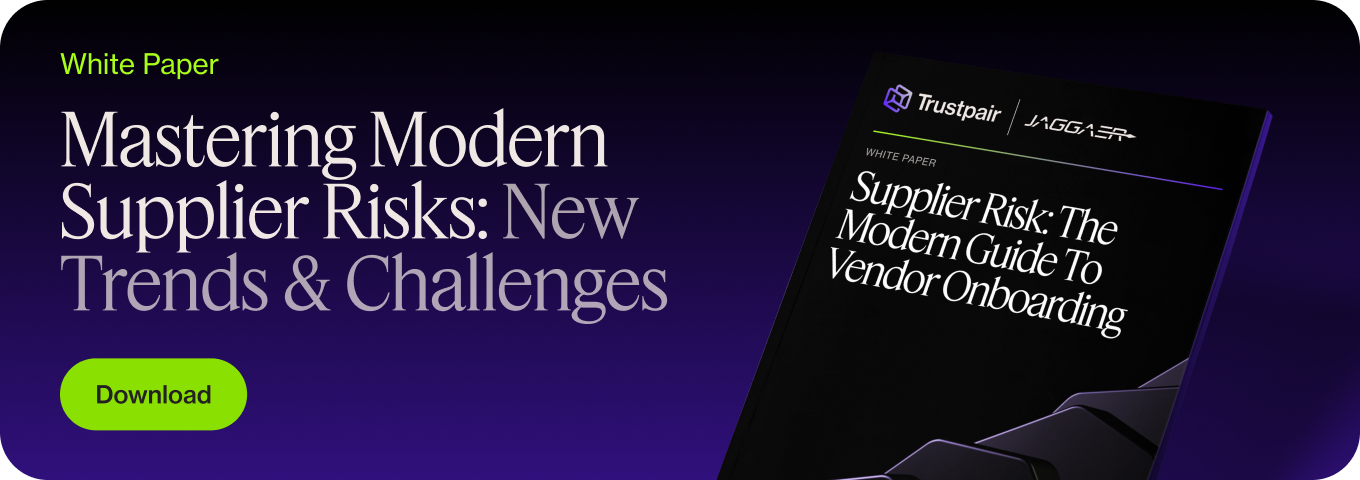The vendor audit process is key to managing risks and ensuring supplier integrity. For instance, audits can uncover fraud or compliance issues, emphasizing the need for thorough evaluations. A structured approach strengthens compliance, mitigates risks, and enhances supply chain security with the help of technology.
Trustpair enhances the audit process by verifying vendor identities and bank account details in real time, reducing vendor fraud risks and ensuring data accuracy. This helps streamline audits, improve compliance, and protect your business from potential financial threats. Contact us to learn more!
What is a vendor audit?
A vendor audit is a thorough evaluation of a supplier’s operations, compliance, and financial practices to ensure they align with your organization’s standards and expectations. It can take place during an RFP process for example – learn about the differences between RFI and RFP here. But how exactly does it work?
Let’s break it down into key elements:
Risk management
The audit process involves assessing potential vendor risks—like vendor fraud, financial instability, or security gaps—that may impact your business operations. For instance, by evaluating vendor data and financial records, you can identify red flags and mitigate risks before they escalate.
Compliance and quality assurance
Vendors must meet industry standards and regulatory requirements to ensure consistent quality and security. During an audit, auditors will verify compliance with these regulations, making sure your vendor’s operations align with your organization’s risk management strategies.
Vendor performance
A vendor audit also reviews the supplier’s ability to meet contractual obligations and deliver the expected quality and service. Are they meeting deadlines? Are they providing the agreed-upon quality? These are crucial aspects that ensure reliable partnerships.
Security measures
In today’s digital world, security is a top concern. A vendor audit includes evaluating the vendor’s security protocols to prevent potential breaches or unauthorized access to sensitive data. This is particularly important when dealing with a third-party assessment that manages critical financial or operational data.
Key steps in the vendor audit process
The vendor audit process is a systematic way to assess your suppliers and ensure they meet your standards. Here’s a breakdown of the key steps involved:
1. Planning and preparation
Before starting an audit, it’s important to plan ahead. First, define the objectives of the audit, such as checking financial stability, ensuring compliance, or assessing risk management practices. You also need to decide which vendors to audit based on their importance to your business and risk level. During this stage, gather the necessary documents and inform the vendor about the audit process.
2. Data collection and analysis
The next step is to gather and review information from the vendor. This includes financial records, compliance reports, and operational data. The goal is to check if the vendor’s information is accurate and reliable. You’ll also look for any red flags, such as discrepancies in their records or weak points in their security measures, to assess the vendor risk.
3. On-site and off-site audits
Depending on the audit’s scope, you may conduct both on-site and off-site audits. On-site audits involve visiting the vendor’s location to observe their operations and speak with key staff. Off-site audits can be done remotely by reviewing records or conducting interviews. Both methods help assess how well the vendor is meeting your standards for quality and compliance.
4. Identifying risks and issues
As you review the vendor’s operations, keep an eye out for potential risks. These could include financial problems, security vulnerabilities, or compliance issues. Finding these red flags early allows you to address problems before they affect your business. Identifying risks is a key part of the vendor risk management process.
5. Reporting and follow-up
Once the audit is complete, you’ll compile a report that details your findings, including any risks or compliance issues. The report should also suggest actions the vendor can take to improve. After presenting the report, follow up with the vendor to discuss the issues and agree on a plan to resolve them.
6. Ongoing monitoring and improvement
A vendor audit should be part of a continuous process. After the audit, keep monitoring the vendor’s performance to ensure they continue to meet your standards. Regular audits help maintain strong vendor relationships and minimize vendor risks over time.
What key metrics should you evaluate during a vendor audit?
The vendor audit process helps organizations evaluate critical metrics to ensure suppliers are reliable, compliant, and aligned with their standards. Here are the key areas to focus on:
Financial Stability
Assess the vendor’s financial health by reviewing:
- Financial statements for profitability.
- Credit ratings and payment history for reliability.
Compliance and Quality
Vendors must comply with regulations and meet quality standards. Check for:
- Adherence to industry standards like ISO or GDPR.
- Defect rates and certifications indicating quality assurance.
Data Security
Vendors handling sensitive data should have strong cybersecurity measures in place, such as:
- Encryption and access controls.
- Compliance with data privacy laws (e.g., GDPR).
Use questionnaires or third-party audits to confirm their data protection measures.
Performance and Resilience
Evaluate the vendor’s reliability through:
- On-time delivery rates and customer satisfaction.
- Supply chain resilience, including contingency plans for disruptions.
Ethical Practices
Examine the vendor’s commitment to ethical and sustainable practices, such as:
- Labor policies ensure fair treatment.
- Environmental sustainability initiatives.
Why is vendor risk management critical?
Vendor risk management is crucial for maintaining stability, protecting data, and ensuring compliance. In today’s interconnected business landscape, disruptions or failures from vendors can have significant ripple effects.
Reducing Operational Risks
Vendors directly impact supply chains and service delivery. Poor management can result in:
- Delays disrupting production schedules.
- Quality issues affecting customer satisfaction.
- Service interruptions halting operations.
Proactive risk management minimizes these disruptions and ensures continuity.
Ensuring Compliance and Security
Non-compliance or weak cybersecurity from vendors can lead to:
- Regulatory fines and legal penalties.
- Data breaches compromising customer trust.
- Reputational harm from unethical or non-compliant practices.
Safeguarding Finances and Reputation
Vendor insolvency or ethical lapses can cause financial loss and reputational damage. Effective risk management ensures suppliers are financially stable and aligned with your values.
Preparing for Global Challenges
Global uncertainties, like natural disasters or geopolitical events, can disrupt supply chains. Vendor risk management helps identify vulnerabilities, develop contingency plans, and build resilience.
Learn more about supplier risks and vendor onboarding in our white paper co-created with JAGGAER!
How can technology enhance the vendor audit process?
Technology revolutionizes the vendor audit process, making it faster, more precise, and scalable with innovative tools and solutions.
Automating Data and Risk Analysis
Platforms like Trustpair and others automate the collection and analysis of vendor data, such as compliance certifications and financial records. For example:
- Software that can flag unusual patterns in payment behaviors.
- Real-time dashboards provide instant insights into vendor performance and risks.
These tools allow businesses to act swiftly and mitigate potential issues.
Improving Collaboration
Cloud-based systems, such as shared audit platforms, enhance communication by offering:
- A secure space for vendors to upload compliance documents.
- Automated tracking of corrective actions, ensuring nothing falls through the cracks.
This transparency strengthens trust and speeds up resolution times.
Boosting Efficiency
Automation tools streamline repetitive tasks. For instance:
- Automatic reminders for certificate renewals prevent compliance gaps.
- Instant report generation saves time in audit preparation and follow-ups.
To conclude
An effective vendor audit process is crucial for managing risks, ensuring compliance, and fostering reliable partnerships. Leveraging technology not only streamlines audits but also enhances decision-making, helping businesses build resilient and trustworthy supply chains.
Trustpair simplifies this process with its platform, offering real-time insights and automated risk assessments. By leveraging our services, businesses can build trustworthy supply chains with ease.






